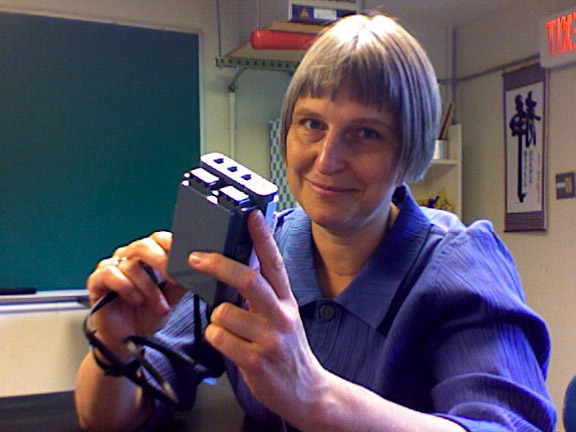Feature: Physics in Play

- Barbara Bratzel

Even in an era when science teachers increasingly look for exciting classroom projects, Barbara Bratzel seems to break new ground.
A 28-year teaching veteran at the private Shady Hill School in Cambridge, Mass., Bratzel has used mechanics, programmable Lego™ NXT blocks, robots and robotic devices, rockets and even candy in projects and demonstrations with students.
In July, 2008, for instance, Bratzel’s fourth-grade science students joined the High Altitude Lego Extravaganza, designed to send Lego machines to the edge of the earth’s atmosphere (nearly 100,000 feet) using two balloons. The students decided to send some yellow marshmallow Peeps candy, along with sensors (made from a Lego machine), to measure pressure and temperature.
When the marshmallows descended, the students measured the candy and found that the Peeps had decreased in volume and mass. This exercise helped the students to better understand pressure and other changes in near-space conditions.
“Her style is very much open-ended design and looking for diversity in solutions,” says Chris Rogers, director of the Center for Engineering Education and Outreach at Tufts University, who aided Bratzel in the project. Her approach, he adds, is one of “empowering kids to make their own choices rather than everyone doing the same thing.”
For Bratzel, who teaches fourth-grade science and eighth-grade physics, engineering is “a powerful vehicle for teaching math and science” and should be introduced at an early age. Legos have become one of her favorite tools. In fact, she has written a Lego robotics activity book for teachers, now in its third edition, called Physics by Design, which is also the name of her 8th grade course.
She’s not alone in finding that kids enjoy working with Legos. The Danish toy company, which verged on bankruptcy five years ago, saw its profits shoot up by 32 percent last year despite an overall market slowdown.
Bratzel’s 8th graders recently created their own pan balances, which are scales with two flat surfaces. Using Legos, string and a set of metric balances, they had to program a Lego NXT block so that the weight measured by their scales was accurate to within 0.5 grams.
Once their scales were ready, the students measured four unknown objects and recorded the weights, putting their scales to the test. From this exercise, the students learned how weight management works, as well as how to build a complex scale with attention given to accuracy. The students also created “snail cars,” which, while required to move mechanically, were designed to move as slowly as possible. In the slowest car, “the motor had to turn 6.6 x 1049 times for the wheels to turn once,” she says.
One of the best ways to engage students, Bratzel says, is to set a mature tone in class through basic project rules. The rules include: no criticizing of others’ work, even as a joke; no project designs are “private property,” and groups are encouraged to use good ideas from other groups in their projects; and failure is expected and is necessary to the learning process. Bratzel has “found that these project rules have improved the quality of the projects, the camaraderie of the class, and the willingness of the students to take risks.”
Bart Horn, a former Bratzel student who is now pursuing an advanced degree in theoretical physics at Stanford University, recalls: “Ms. Bratzel would keep the room open and the Lego sets out during recess so we all could have extra time to work on our final projects. It was easy to get carried away.”
Bratzel, who in the course of her career has taught every grade level from kindergarten to 12th, views teaching science, physics and engineering as a civic as well as an educational responsibility.
“Science literacy in this country is at a dismayingly low level,” she says in an email. She notes that “40 percent of people in a recent poll did not believe in evolution,” making teaching science more important than ever. “Besides basic science knowledge, I want my students to be able to evaluate evidence and draw appropriate conclusions from it, a skill that is important in all aspects of life as well as vital in science.”
Filed under: Special Features








